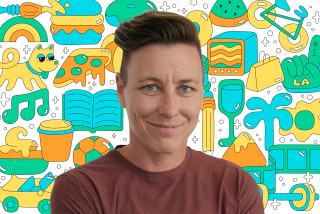Santa Clarita Blue Heat women’s soccer story is a Hollywood gem
The Santa Clarita Blue Heat may be the most interesting women’s soccer team you’ve never heard of.
It’s a French Foreign Legion in shin guards and rubber cleats, with players from six countries — seven if you count the Pennsylvanian who spent last summer playing in Iceland. And every one of them has a story to tell.
“It’s funny sometimes, the mix,” captain Edite Fernandes, who is also captain of the Portuguese national team, says in Spanish, one of four languages represented on the Blue Heat roster. “We learn a little bit from everyone. It’s a novel experience.”
A Charles Dickens novel, apparently. Because, like “The Old Curiosity Shop,” the Blue Heat has a little bit of everything.
There’s the famous — midfielder Dinora Garza played for Mexico in last summer’s World Cup — and the infamous — defender Elizabeth Lambert was widely derided as the meanest player in soccer after a vicious hair-pulling meltdown in a college game 21/2 years ago.
There’s the courageous, like 20-year-old midfielder Holly Hein, who is battling thyroid cancer. And the slightly outrageous, like midfielder Fabiana Meredith, a 33-year-old mother of two who left her family back in South Dakota to take one more shot at living her soccer dream.
And we haven’t even mentioned the most talented player on the team, forward Nadia Link, who was once homeless and living in a car parked behind a gas station in West Covina.
“Every single person on this team has their own unique, amazing story,” says Meredith, who retired six years ago, then hobbled back on a bum knee this spring to see if she could still play. “I would say it’s the greatest experience I’ve had in soccer.”
If the Blue Heat is a ragtag bunch of soccer survivors, though, then so is the United Soccer W-League in which it plays.
With two women’s pro leagues folding in the U.S. in recent years, the 30-team pro-am league is now the oldest and highest-ranked women’s league in North America, playing a 10-week, 14-game, regular-season schedule. And many of those matches are played not in stadiums but on fields generally reserved for high school or AYSO teams.
The Blue Heat’s home, for example, is Valencia High, where it will play Sunday afternoon before a small gathering made up largely of family and friends. After Sunday the team has four games left this season, all at home; its last game is July 17.
“There’s no way to have a pro league in the U.S. It’s too expensive,” says team owner Carlos Marroquin, pointing to the defunct Women’s Professional Soccer league and its marquee player Marta, whose exorbitant salary was a factor in the collapse of three franchises and, eventually, the league itself.
And though USL rosters are peppered with international players — the Blue Heat has national team veterans from Brazil, Panama, Portugal, Mexico and Canada — the league also relies heavily on college athletes, which has led to a couple of problems. Collegians can lose their NCAA eligibility if they compete against pros, so USL teams can offer no more financial incentive than room and board to their recruits.
Still, the players come.
“To avoid stopping I came here,” says Fernandes, 32, who has supported herself playing in leagues in Portugal, Spain and China but comes to the U.S. during the off-season to stay fit. “But it’s very important to have a league that lasts longer than three months.”
That’s the second problem. Because most schools are in session from August through May, NCAA players are available to play in the USL only in the late spring and early summer, forcing the league to compact its schedule.
“For the rest of the year,” Marroquin says, “we have to be happy to watch good college soccer.”
That would mean watching Link, a three-time all-CIF selection at Walnut High who was kicked out of her parents’ house and forced to forfeit a scholarship to UC Irvine after getting pregnant just before graduation day.
Over the next several months she moved from house to house, sleeping for a while on a relative’s sofa before moving into a weather-beaten 10-year-old Lexus so stuffed with junk the seats wouldn’t recline. She refused to give up the baby, moving back in with her family just before giving birth to a daughter, Adrianna, three years ago.
When the ordeal ended, Link rushed back to the soccer field.
“I had to work really hard to earn what I got,” says Link, 22, who was the Big West Conference offensive player of the year last fall at Long Beach State, which helped earn her an invitation to training camp with the U-23 U.S. national team.
Soccer is also helping Hein overcome her own life crisis, which began last summer when she was told that she had cancer. “Soccer is probably the first thing I thought of,” says Hein, a junior at the University Michigan. “I didn’t want to be anywhere else.”
That seems fitting since it was soccer that probably saved her life.
Doctors first noticed the lump on her neck while prepping her for surgery to repair an anterior cruciate ligament torn during a match. But even with a tumor Hein couldn’t turn her back on the game, starting six matches for the Wolverines last fall before undergoing another operation to remove her thyroid and the surrounding lymph nodes.
She now has clean bill of health, which allowed her to return to soccer full time this spring. That was about the same time Meredith started her own comeback, showing up on Marroquin’s doorstep and asking for one last chance to play — albeit on a team with players nearly half her age.
“I’m doing this because it’s what I love to do,” says Meredith, who has yet to appear in a game because of a chronic knee injury. “I guess I came to a point where I realized that I can still play, but I’m not going to be able to play forever. If I didn’t do it I would, for the rest of my life, wonder and I’d have something I regret.”
No regrets. If the diverse Blue Heat could settle on a motto, those two words would probably fit better than any others.







